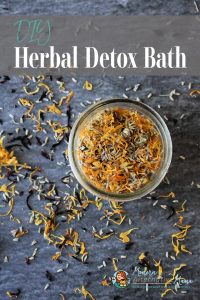By Sarena-Rae Santos, Natural Health Blogger
Whether you’ve taken detoxing to the next level with a detox garden or are just looking for a nice herbal detox bath recipe, this post is for you. Before we get started with our herbal detox bath recipe, let’s talk about the #1 detox mistake.
But first, what is a detox?
A “detox” helps, first, to open overburdened detox pathways – liver, kidneys, lymphatic, and bowel. These pathways are in our bodies to help us detox from all the junk in the world around us. But if we are exposed to too many toxins at once, we can become sluggish and overworked. The goal is to help them get working normally again!
The second part of a detox is often forgotten, which is removing toxins from body parts where they have been stored – fat, muscles, lymphatic fluid, blood, or even the brain. It can be dangerous to knock these toxins loose if the detox organs aren’t open and working correctly because then the body can’t eliminate the toxins, which can circulate and cause further damage. The #1 detox mistake is not supporting your body’s natural detox pathways; many “detox plans” don’t emphasize this enough. That’s where an herbal detox bath comes in.
While detoxing, you should be:
- Supporting your liver
- Supporting your kidneys
- Supporting your lymphatic system
- Supporting your gut
- Supporting your immune system
- Supporting your adrenals
- Supporting your entire body
At the end of this post is an “additional detoxing resources” section that you could use to further your knowledge.
Benefits of the Herbs
Before we go over the directions, let’s discuss the health benefits of the herbal bath detox, which combines four herbs (calendula, sage, yarrow, and ginger).
Calendula is used because it has natural anti-inflammatory and antibacterial properties. Steeping in the benefits of this herb helps speed up the healing process. Additional health benefits of calendula include:
- Rich in antioxidants (1)
- Spasmolytic and spasmogenic properties (2)
- Antiviral properties (3)
- Antifungal properties (4)
- May promote wound healing (5)
- May improve skin health (6)
- May support heart health (7)
- May support oral health (8)
- Anticancer properties (9)
Sage has been used for many years as a detoxifying, purifying herb. This herb is known for its all-over body benefits. Additional health benefits of sage include:
- Rich in nutrients (10)
- Antioxidant properties (11)
- Antibacterial properties (12)
- May reduce blood sugar levels (13)
- May support heart health (14)
- May support brain health (15)
- May support oral health (16)
- Anti-aging properties (17)
- May provide menopause symptom relief (18)
- Anticancer properties (19)
Yarrow is used because it benefits overall gut health. Additional health benefits of yarrow include:
- Anti-inflammatory properties (20)
- May promote wound healing (21)
- May improve digestion (22)
- May improve mental health (23)
- May improve brain health (24)
- Anticancer properties (25)
Ginger is used because it helps with all the gastrointestinal system processes and fights infection. Additional health benefits of ginger include:
- May ease nausea and morning sickness (26)
- May relieve chronic ingestion (27)
- May improve blood sugar levels (28)
- May lower cholesterol levels (29)
- May help manage osteoarthritis (30)
- May reduce menstrual pain (31)
- May improve brain functionality (32)
- May aid in weight loss (33)
- Antibacterial properties (34)
- Anticancer properties (35)
Honorable Herbal Mentions
Catnip can be used for its anti-inflammatory, sleep-promoting, or stress and anxiety-relieving properties.
Chamomile can be used for its anti-inflammatory, sleep-promoting, or heart health properties.
Lavender can be used for its anxiety-relieving, anti-inflammatory, or wound-healing properties.
Lemon balm can be used for its pain-relieving, cognitive function, or stress and anxiety-relieving properties.
Rose petals can be used for their anti-inflammatory, antibacterial, antiseptic, or mood-enhancing properties.
Some recipes you can make with all the honorable herbal mentions include:
A relaxing blend: 1 part each rose, lavender, lemon balm
An Immune-supporting blend: 1 part each calendula, lemon balm, sage
Herbal Detox Bath
Ingredients:
Directions:
Step 1: Mix all of the ingredients in a large bowl and scoop into a gallon-size Ziploc bag or large mason jar for storage.
Step 2: Once you’re ready to use it, add 1 cup of the herbs to 2 quarts of boiling water and let steep, covered, for 20 minutes.
Step 3: Strain the herbs, pour the “tea” into a nearly full bath and soak for as long as you want.


